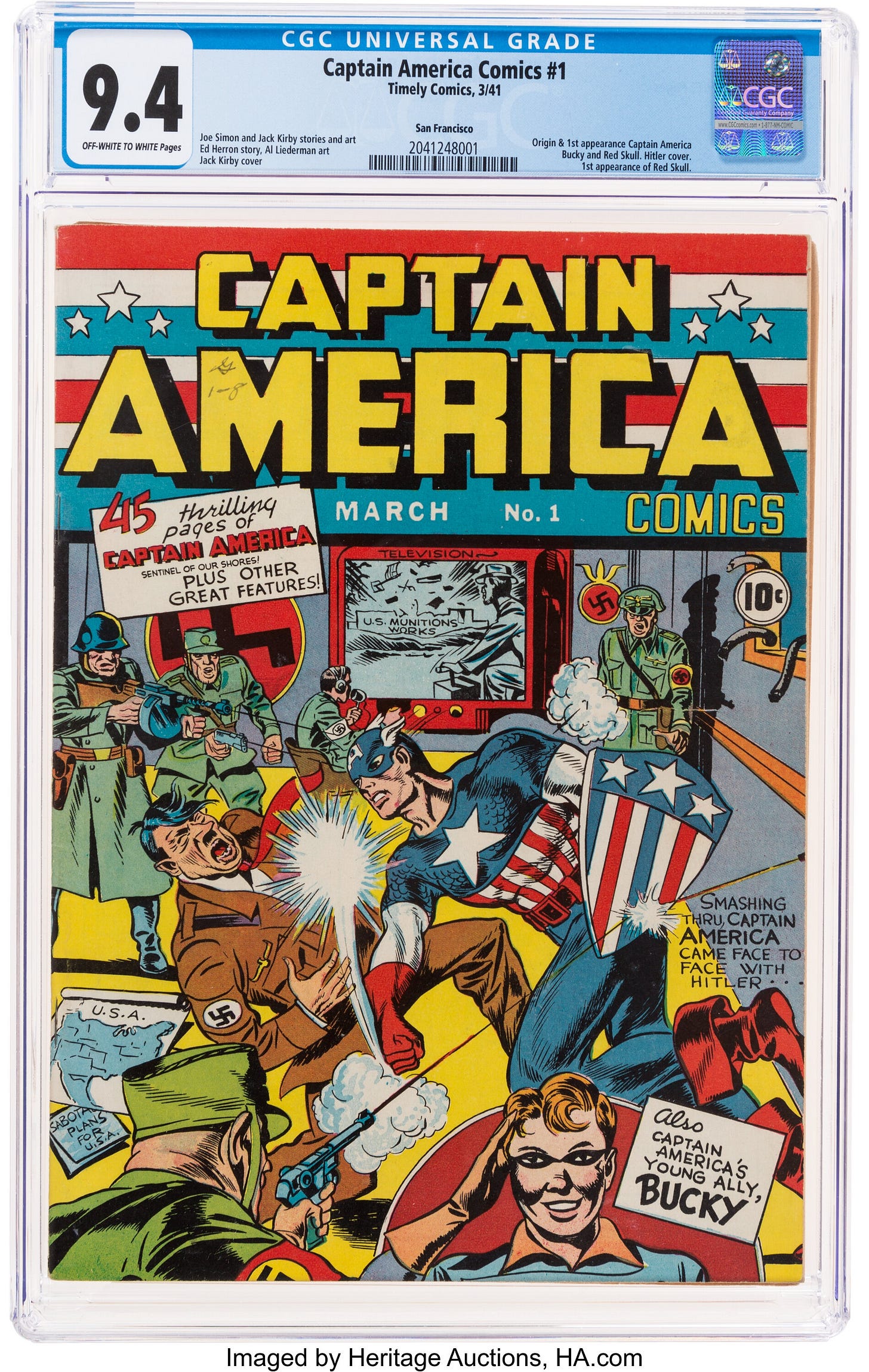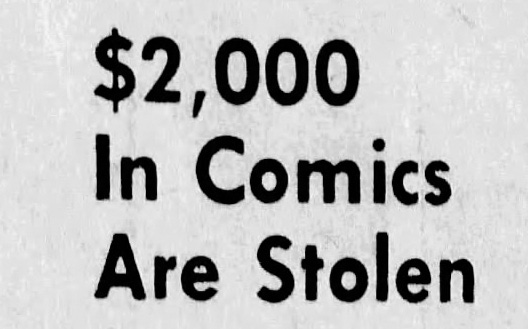The Captain America Caper: A $3 Million Comic's Journey from Theft to Auction
A rare Golden Age comic's 40-year journey back to market
The Captain America Caper1
In the world of comic book collecting, provenance stories matter. And few comics have a story quite like the “San Francisco” copy of Captain America Comics #1, a book that went from a $10 comic-con purchase to a stolen treasure to a $3.1 million auction record.
The book itself is legendary: the debut comic introduced Captain America to the world with the patriotic superhero punching out Adolf Hitler. It hit newsstands in early 1941, nearly a year before the US joined World War II, making the cover seem like a prophecy or preordained history. The San Francisco copy would make history of its own.

In May 1973, someone walked into the Berkeley Comic Convention with boxes of Golden Age comics dating from the late 1930s to about 1945. The collection was massive and in spectacular condition, and comics with this provenance are known as the “San Francisco pedigree” by collectors.
Over the years, many different names have attached to the sellers, none of which can be verified. The most widely circulated story is that a young man started the collection before the Second World War and his parents kept buying the comics he liked after he joined the Navy. Supposedly he was killed in a Japanese kamikaze attack, which is why the collection ends in 1945. Depending on who you ask, either the parents or their heirs decided to sell the comics in the early 1970s. None of this story is true either.
Here’s what we do know:
Two of the convention organizers, Nick Marcus and Mike Manyak, happened to be at the ticket desk. The pair already sold comics together, and they immediately worked out a deal for what they considered the cream of the collection—all the books from Timely Publications, the predecessor to Marvel Comics. The highlight was Captain America #1.

When I spoke to Nick recently, he recalled paying $10 for each comic, which he now concedes was “a little bit of a rip off.” When I asked why they didn’t try to get the whole collection, his answer revealed the eternal collector’s dilemma: quantity or quality? Nick had wanted to buy everything, but Mike insisted, “No, we just need to buy these.” So they went with quality.
Riding high on their purchase, Nick and Mike opened Shazam Comic Art Shop in Walnut Creek, California. Nick ran the shop and became something of a local comics evangelist, giving presentations around town and publicizing their rare comics. One article announced that three key Timely first issues—Captain America, Human Torch, and Submariner—could be found at their store.2
The publicity worked too well. On Saturday, December 29, 1973, a man Nick remembers as a lawyer came into Shazam. He’d visited before, but this time he asked to use the restroom. The rare comics, including Cap 1, which is how comic collector universally refer to Captain America #1, were lying out in the open on the way to the bathroom. In hindsight, Nick admits that wasn’t smart. The comics disappeared that day.
Nick filed a police report about the theft of six comics3 worth $2,000—a fortune in 1973 when comic collecting was still quite niche. He told the newspaper that Cap 1 alone was worth at least $1,000 and that he knew of a copy that had sold for twice that. The Walnut Creek police never cracked the case. The theft broke up Nick and Mike’s partnership, and Shazam Comics closed a year later. Nick left comics entirely, moving to Texas to work in oil exploration. “It really took it out of me,” he said. “Comics weren’t much fun anymore.”
The story might have ended there, but in 2019, Heritage Auctions announced the coming sale of “one of the most famous copies of one of the most famous comics”—the San Francisco copy of Captain America #1. The distinctive markings on its covers identified it as the stolen comic. Somehow Heritage knew its troubled history (they’re not at the top of their field by accident).
What exactly happened next remains clouded. I suspect non-disclosure agreements are involved, as Mike Manyak wouldn’t talk to me at all and Nick said he couldn’t discuss it. But we know this: more than 40 years after the theft, Heritage worked out a deal. They would only say that “all parties involved entered into an agreement that cleared title and allowed for the auction.”
The comic sold for $915,000.
Three years later, the San Francisco Cap 1 returned to Heritage and rode the Covid-era boom in comic prices to an astonishing $3,120,000.
Some questions remain.
Did Nick and Mike’s settlement approach anything close to the eventual sale price? They wouldn’t even say that they had been paid, but I’m pretty sure they got a settlement. I asked several comic book collectors who have known Mike for many years if they noticed he came into a lot of money in 2019. They all said no.
Was the consignor an innocent third party or someone closer to the original theft?
And perhaps most intriguingly—does this $3 million comic now travel with documentation proving it’s officially “unstolen,” or does its owner simply have to take it on faith?
The San Francisco Cap 1 reminds us that in collecting, every object tells two stories: the one it was created to tell, and the one it lives to tell. Sometimes the latter proves even more valuable than the former.
—Scott Brown, Downtown Brown Books
This essay originally had a sequel. For a variety of reasons, I decided to let this story stand on its own, and I took down the second part.
Contra Costa Times, Wednesday, October 10, 1973, p. 30.
The other books stolen that day were Marvel Mystery #2 and #13, All Winners #1, and Detective Comics #7 (a Platinum Age book).






Looking forward to “Chapter Two”. As always, an entertaining and educational read. Thanks Scott.
I love this